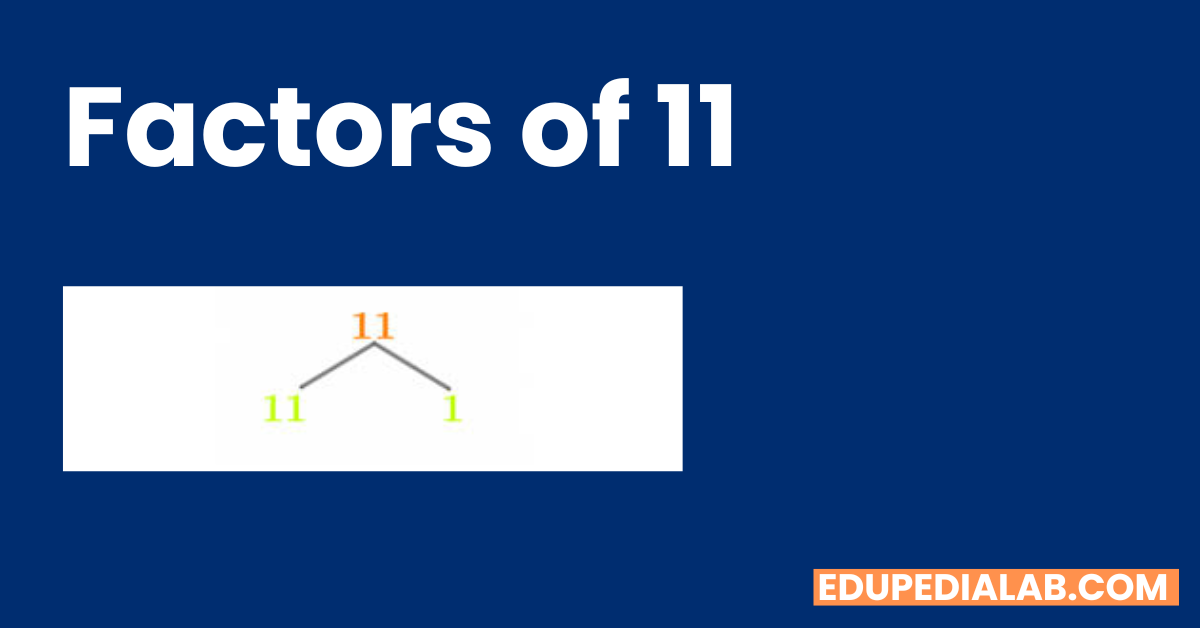Factors of 11
When it comes to mathematics, factors play a crucial role in understanding the relationships between numbers. In this article, we will delve into the world of factors, specifically focusing on the factors of 11. We will explore what factors are, how they relate to 11, and their significance in number theory. So let’s dive in and unravel the mysteries behind the factors of 11. The number 11 is very unique in many ways that it is one of the Factors Of 33.

Understanding Factors
Before we delve into the specifics of factors of 11, let’s first understand what factors are in mathematics. Factors are whole numbers that can be evenly divided into another number without leaving a remainder. For example, the factors of 12 are 1, 2, 3, 4, 6, and 12, as these numbers can be multiplied together to give the number 12.
What Are Factors of a Number?
Factors of a number are the numbers that divide the given number without leaving any remainder. In the case of 11, the factors are the numbers that divide it evenly. For 11, the factors are 1 and 11. Since 11 is a prime number, it only has two factors: 1 and itself.
Prime Factorization
Prime factorization is the process of expressing a number as the product of its prime factors. For 11, since it is already a prime number, the prime factorization of 11 is simply 11 itself.
Factors of 11: A Closer Look
As mentioned earlier, the factors of 11 are 1 and 11. These two numbers are the only divisors that can evenly divide 11. Any other number would either result in a remainder or would not be a whole number. This unique property of 11 being a prime number makes its factors limited and distinct.
Properties of the Factors of 11
The factors of 11 possess certain interesting properties that are worth exploring. Let’s take a look at a few of them:
- The factors of 11 are both prime numbers, namely 1 and 11.
- Since 11 is a prime number, it cannot be divided evenly by any other number except 1 and itself.
- The sum of the factors of 11 (1 + 11) equals 12.
Relationship Between 11 and Its Factors
The relationship between 11 and its factors is quite simple, yet fascinating. As mentioned earlier, 11 is a prime number, meaning it is divisible only by 1 and itself. This implies that the only factors of 11 are 1 and 11.
When we multiply the factors of 11 together (1 * 11), we get the original number itself, which is 11. This demonstrates a unique property of prime numbers and their factors.
Applications of the Factors of 11
While the factors of 11 may seem simple, they have various applications and implications in different fields. Let’s explore a few examples:
- Cryptography: Prime numbers, such as 11, play a crucial role in modern cryptography algorithms, ensuring secure communication and data encryption.
- Mathematics: Factors and prime numbers are extensively used in number theory, algebra, and other branches of mathematics for solving equations, proving theorems, and exploring mathematical patterns.
- Divisibility Rules: The factors of 11 contribute to divisibility rules. For instance, if the alternating sum of the digits of a number is divisible by 11, then the original number is also divisible by 11.
Divisibility Tests Involving 11
Divisibility tests are an essential tool in number theory to determine whether a number is divisible by another number without performing the actual division. Here are a couple of divisibility tests involving 11:
- Alternating Sum Test: To check if a number is divisible by 11, sum the alternating digits of the number and check if the result is divisible by 11. For example, for the number 924, we have 9 – 2 + 4 = 11, which is divisible by 11, indicating that 924 is divisible by 11.
- Repeated Digit Test: Another test involves doubling the last digit of the number and subtracting it from the remaining digits. If the result is divisible by 11, then the original number is also divisible by 11. For example, for the number 242, we double 2 to get 4 and subtract it from 24, resulting in 20. Since 20 is divisible by 11, we conclude that 242 is divisible by 11.
Interesting Patterns with 11 and Its Factors
Exploring the properties of 11 and its factors reveals intriguing patterns. For instance:
- Repeated Factors: Since 11 is a prime number, it only has two factors: 1 and 11. Unlike composite numbers that can have multiple factors, prime numbers have a repetitive pattern of factors.
- Symmetry: The factors of 11 exhibit a symmetrical pattern. Both 1 and 11 are equidistant from the center, showcasing a symmetrical arrangement.
The Significance of 11 in Mathematics
In mathematics, the number 11 holds a special place due to its prime nature and distinct properties. It is one of the building blocks of prime numbers and plays a role in various mathematical concepts, including number theory, algebra, and cryptography.
Real-World Examples
The significance of the factors of 11 can be observed in real-world scenarios. Here are a few examples:
- Clocks and Time: A clock typically has 12 hours, and the hour hand moves in a circle. When it reaches 11, it has covered 11/12th of the total distance, indicating the importance of 11 in measuring time.
Conclusion
In conclusion, the factors of 11 are 1 and 11. As a prime number, 11 has a unique set of factors that contribute to its distinctiveness. Understanding factors and their properties is essential for various mathematical applications. The study of factors enriches our comprehension of numbers and their relationships, leading to deeper insights into the world of mathematics.

1 thought on “Factors of 11 (Explained By Experts)”